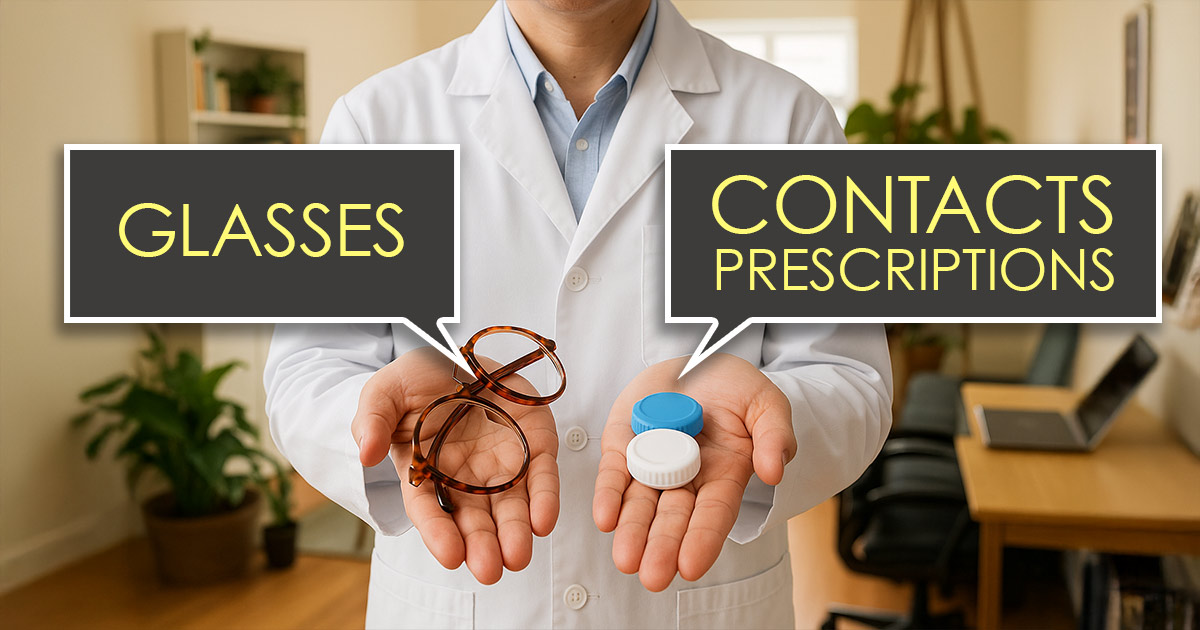Glasses vs. Contacts Prescriptions: What’s the Real Difference?

If you wear glasses or contacts (or both!), you’ve probably wondered, “Are they the same thing?” It’s a common question, and the short answer is no. Glasses and contact lens prescriptions are pretty different, and it all comes down to how each type of lens fits and works for your eyes.
Understanding why they aren’t the same can save you from potential headaches (literally) and blurry vision. Plus, knowing how to get the right prescription will make your life a whole lot easier.
What Makes Glasses and Contact Lens Prescriptions Different?
The main reason glasses and contact lens prescriptions aren’t interchangeable is their distance from your eye. Glasses sit about half an inch away from your eyeballs, while contacts rest directly on your eye’s surface. This difference might sound small, but it’s a big deal for vision correction. Here’s why:
Prescriptions That Work for Your Setup
Glasses Prescriptions are designed for lenses that hover over your nose and ears. They include your lens power (sphere), astigmatism details (cylinder and axis), and sometimes a value called “add” for multifocal glasses.
Contact Lens Prescriptions take things a step further with extra details like the base curve (the curvature of the lens) and diameter (its size). These measurements ensure the lens fits snugly and comfortably on your eye.
For instance, if your glasses prescription says you have mild astigmatism and need cylinder correction, your contact lens prescription will not only adjust for this but also figure out how the lens physically sits on your cornea.
Imagine This:
You wouldn’t wear one-size-fits-all shoes, right? Contact lenses are kind of like custom-fit footwear for your eyes. You need the right measurements, or they’ll either feel terrible or fall flat (literally).
Why You Can’t Swap One for the Other
It’s tempting to think your glasses prescription can double as a contact lens prescription. I mean, they’re both for seeing better, aren’t they? But nope! Here’s why:
1. Distance Affects Power
The corrective power for your lenses varies because glasses sit away from your eyes, while contacts sit right on them. This means even if the numbers in your glasses prescription look similar, they’ll need tweaking for contacts. For higher prescriptions (like strong nearsightedness), this adjustment becomes even more significant.
2. Contacts Fit on Your Eyeballs
This might sound obvious, but contacts stick to your eyeballs, and your two eyes aren’t necessarily identical. Contacts have to fit the curve and size of each eye perfectly, or they’ll move around and mess with your vision entirely. A glasses prescription doesn’t factor in the precise shape of your eye.
3. Tears Matter for Contacts
During a contact lens exam, your eye doctor also checks your tear production. Why? Contacts float on a tiny layer of moisture from your tears, which keeps them comfortable and safe to wear. If your eyes are dry, your doctor might recommend special lenses or suggest glasses for some days instead of contacts.
Everyday Example
Picture this: You wear contacts with a prescription meant for glasses. Suddenly, everything looks blurry, and your eyes start to feel scratchy. That’s because the contact lens isn’t adjusted for its proximity to your eye or its fit! This is why you should never skip a proper contact lens fitting.
How to Get the Right Prescription
If you’re wondering, “How can I get contacts with my glasses prescription?” the answer is straightforward. You’ll need a contact lens exam. Here’s what happens during this two-step process:
Step 1: Check Your Vision
Just like in a standard eye exam, the doctor will figure out your lens power to correct any nearsightedness, farsightedness, or astigmatism.
Step 2: Measure Your Eye Shape
The doctor will also measure your cornea (the front surface of the eye), iris (the colored part), and tear film to choose lenses that fit like a glove. After these steps, you’ll get trial contacts to try out before finalizing the prescription.
Regular eye exams are essential to keeping your vision sharp and your prescriptions up-to-date since your eyes can change over time.
Glasses vs. Contacts: Which Should You Choose?
Glasses Are Great If…
- You want a hassle-free option.
- You love switching up your look with stylish frames.
- You need something low-maintenance without worrying about eye irritation.
Contacts Are Perfect If…
- You’re active and love the freedom of being glasses-free.
- You dislike the weight of glasses on your face.
- You find it easier to deal with clear, no-obstruction vision during workouts or special occasions.
Many people choose to use both! For instance, wear glasses on work-from-home days or when you’re relaxing. Switch to contacts for sports, nights out, or when you don’t want frames blocking your field of view.
See Clearly, Feel Great: The Power of the Right Prescription
Fumbling with whether you could use the same prescription for glasses and contacts is not efficient. Trust me, ensuring you have separate, accurate prescriptions is worth it. Once you have both, you’ll enjoy the clarity and comfort that come with it. Feeling stylish in frames one day and effortlessly free with contacts the next? That’s a win in my book.
Take care of your eyes, stay on top of regular checkups, and your prescription (or prescriptions!) will always have you seeing your best. Whether you’re Team Glasses, Team Contacts, or a mix, the most important thing is clear, healthy vision!
